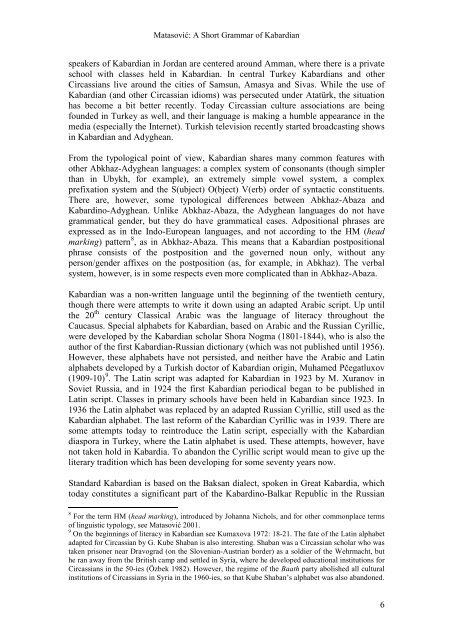PREGLED KABARDINSKE GRAMATIKE - Cryptm.org
PREGLED KABARDINSKE GRAMATIKE - Cryptm.org
PREGLED KABARDINSKE GRAMATIKE - Cryptm.org
Create successful ePaper yourself
Turn your PDF publications into a flip-book with our unique Google optimized e-Paper software.
Matasović: A Short Grammar of Kabardianspeakers of Kabardian in Jordan are centered around Amman, where there is a privateschool with classes held in Kabardian. In central Turkey Kabardians and otherCircassians live around the cities of Samsun, Amasya and Sivas. While the use ofKabardian (and other Circassian idioms) was persecuted under Atatürk, the situationhas become a bit better recently. Today Circassian culture associations are beingfounded in Turkey as well, and their language is making a humble appearance in themedia (especially the Internet). Turkish television recently started broadcasting showsin Kabardian and Adyghean.From the typological point of view, Kabardian shares many common features withother Abkhaz-Adyghean languages: a complex system of consonants (though simplerthan in Ubykh, for example), an extremely simple vowel system, a complexprefixation system and the S(ubject) O(bject) V(erb) order of syntactic constituents.There are, however, some typological differences between Abkhaz-Abaza andKabardino-Adyghean. Unlike Abkhaz-Abaza, the Adyghean languages do not havegrammatical gender, but they do have grammatical cases. Adpositional phrases areexpressed as in the Indo-European languages, and not according to the HM (headmarking) pattern 8 , as in Abkhaz-Abaza. This means that a Kabardian postpositionalphrase consists of the postposition and the governed noun only, without anyperson/gender affixes on the postposition (as, for example, in Abkhaz). The verbalsystem, however, is in some respects even more complicated than in Abkhaz-Abaza.Kabardian was a non-written language until the beginning of the twentieth century,though there were attempts to write it down using an adapted Arabic script. Up untilthe 20 th century Classical Arabic was the language of literacy throughout theCaucasus. Special alphabets for Kabardian, based on Arabic and the Russian Cyrillic,were developed by the Kabardian scholar Shora Nogma (1801-1844), who is also theauthor of the first Kabardian-Russian dictionary (which was not published until 1956).However, these alphabets have not persisted, and neither have the Arabic and Latinalphabets developed by a Turkish doctor of Kabardian origin, Muhamed Pčegatluxov9(1909-10) . The Latin script was adapted for Kabardian in 1923 by M. Xuranov inSoviet Russia, and in 1924 the first Kabardian periodical began to be published inLatin script. Classes in primary schools have been held in Kabardian since 1923. In1936 the Latin alphabet was replaced by an adapted Russian Cyrillic, still used as theKabardian alphabet. The last reform of the Kabardian Cyrillic was in 1939. There aresome attempts today to reintroduce the Latin script, especially with the Kabardiandiaspora in Turkey, where the Latin alphabet is used. These attempts, however, havenot taken hold in Kabardia. To abandon the Cyrillic script would mean to give up theliterary tradition which has been developing for some seventy years now.Standard Kabardian is based on the Baksan dialect, spoken in Great Kabardia, whichtoday constitutes a significant part of the Kabardino-Balkar Republic in the Russian8 For the term HM (head marking), introduced by Johanna Nichols, and for other commonplace termsof linguistic typology, see Matasović 2001.9 On the beginnings of literacy in Kabardian see Kumaxova 1972: 18-21. The fate of the Latin alphabetadapted for Circassian by G. Kube Shaban is also interesting. Shaban was a Circassian scholar who wastaken prisoner near Dravograd (on the Slovenian-Austrian border) as a soldier of the Wehrmacht, buthe ran away from the British camp and settled in Syria, where he developed educational institutions forCircassians in the 50-ies (Özbek 1982). However, the regime of the Baath party abolished all culturalinstitutions of Circassians in Syria in the 1960-ies, so that Kube Shaban’s alphabet was also abandoned.6
















